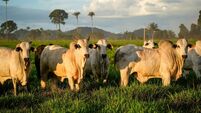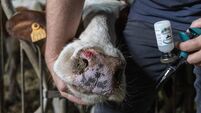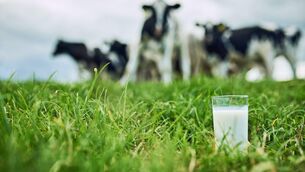Text generation brings the digital revolution into daily farming life
For many people — particularly those of 35 and older — Twitter and Facebook are not much more than a time-consuming annoyance that they just don’t get, but for many in the younger age bracket smart phones have become a standard piece of equipment and the affordability of data packages means that they can be online all the time – even down on the yard.
In a recent poll run by Macra na Feirme of a sample group of 230 farmers, a large majority of respondents (87%) said that they used social media sites such as Facebook and Twitter on a regular basis.
Some 50% of respondents said that they already owned a smart phone, with a further 23% saying that they were considering buying one.
During 2011, statistics show that the percentage of smart phones amongst mobile phone users rocketed from 27% in January to 55% by the end of December.
Aoife Helly, public relations manager with Macra Na Feirme, finds that there has been a huge sea change evident amongst Macra members in the last few years in terms of owning a smart phone.
“A few years ago when we’d ask our members if they had a smart phone and if they would ever consider owning one, a lot of people were saying things like ‘No’ and ‘I’d never get one’,” she says, “but now it’s really changing and more and more people have smart phones. And they’re using them too and they’re looking to get information through their social media.
“Now there’s an expectation for information to be put up online. People want to be updated on what’s happening. When we held our own executive elections in April of last year, we found that a lot of people were following what was going on through their smart phones and they knew the result immediately.
“Many of our members are young and are keen to be on Facebook,” she adds. “I would say that most of our members are on Facebook. Our website is very social-media friendly in that we’ve lots of updates through Twitter and Facebook. Twitter is popular with media types, but not so popular with our members.
“But almost every club uses the Facebook. It has become a great resource for all clubs because getting a website up will cost you money whereas Facebook is free, so clubs especially are using it as a way of communicating.
“Something that we found out through online surveys which surprised us is that many of our members are now using Facebook pages of ours and of member clubs as a way of getting information. That surprised us because we thought that they would be referring to the website for information and to the Facebook page for communication only, but many obviously now only go as far as the Facebook page as an information source.”
The Tweeting farmers are there. According to RTE’s Ear to the Ground presenter Ella McSweeney, they are in a “tiny tiny percentage of farmers” but it’s a minority that is growing, which is highly active, using Twitter both as a way of marketing their produce and of communicating in a social sense and exchange of information.
“From my experience, I would say that most farmers are on Facebook,” says McSweeney, “but a few are on Twitter. Of those on Twitter, most of them would be of the younger generation… For the benefit of a non-farming urban audience, it is fantastic to have farmers on Twitter; situations where people aren’t necessarily following farmers for what they sell but farmers who just talk about farming; who talk about how difficult the weather is; that it might mean they’ll have to bring the cows back inside, which in turn means that there’s a greater cost to be paid… basically talking about the realities that farmers go through on a daily basis — the good and the bad. I think that those things remind people on a daily basis that farming isn’t so straightforward and that there are costs and skills involved.”
Michael Keegan is a 32-year-old sheep farmer in Enniskerry, Co Wicklow. He was very reluctant to get involved in social networking until he was advised to do so.
Now, he sees it as a very important part of his regular business activity both for his farm and for his farm shop in Enniskerry.
“I suppose I was (a reluctant Tweeter), yeah,” he says. “I was always more a vice-grips-and-hammer man rather than a computer man! But we got going on it when we opened up a shop here on the farm and everybody was saying to us ‘You need to be Facebook’ and ‘You need to be on Twitter’ and I didn’t know anything about those things.
“I kind-of reckoned that it was for people who had too much time on their hands, to be honest. I’d still be a little bit of that opinion: I mean that I still use it but we use it for the shop to promote what we have going on in the shop and that’s all we use it for. But I know a lot of people who seem to use it for general chit-chat and some of it seems pretty mindless.
“It is a fantastic tool for marketing. We find it great here: we’ve had countless numbers of people coming to us from having seen us on Twitter or Facebook. We’ve even sold lambs to people who would never have known about us if they hadn’t seen us on the social media.”
John Kelly is another farmer in his early 30s who is an active user of Twitter.
Unlike Michael Keegan, he doesn’t use the social medium as a marketing tool, but rather as a method of communicating with other farmers and with the wider public.
“Twitter is a lot of things to a lot of different people,” says the Wicklow-based sheep farmer, who is a regular Tweeter. “Some of the small producers would just advertise and nothing more… many people would use it to put up links to interesting articles… it’s a handy way of reading a lot of articles that would be of a farming interest, so it’s quite an efficient way of getting information if you follow people of similar interest.”
Kelly also uses his Twitter to keep in touch with what other farmers are doing. The Tweets he sends out often, he says, get a quick reaction. One dairy farmer in Roscommon — Brian Costello — is a regular communicator through Twitter and the two frequently exchange questions and information about grass levels and other technical farming data.
But Kelly also gets questions from the public of a more general nature. Regular followers are fascinated with this insight into farming life, and he once transmitted a series of photographs “live” of a calf being born by Caesarian section.
Ronan Byrne in Co Galway is a farmer who has been using Twitter, not as a direct market tool, but more as a means of networking and sharing thoughts on farming. He has attracted a strong following for his views on getting quality food direct to the public.
In terms of the ability of social media to tackle rural isolation, Twitter or Facebook don’t look like they’re going to replace the rural pub, but there are moments when the task at hand can be a very lonely one and it is these moments that can be rendered less lonely by the virtual presence of someone else via social media.
Kelly says: “You could be out in the middle of a field taking a photo and people will get back to you straight away — people who are interested in the same kind of things that you are.
“I remember being in the sheep shed late at night during lambing season,” says Keegan, “waiting for a ewe to lamb and flicking through the Twitter account having a look and you’d see some other farmer doing the same thing and you’d send one another tweets. Farming is a lonely enough job at times… from that point of view, it does help to some extent with isolation, I suppose.”













